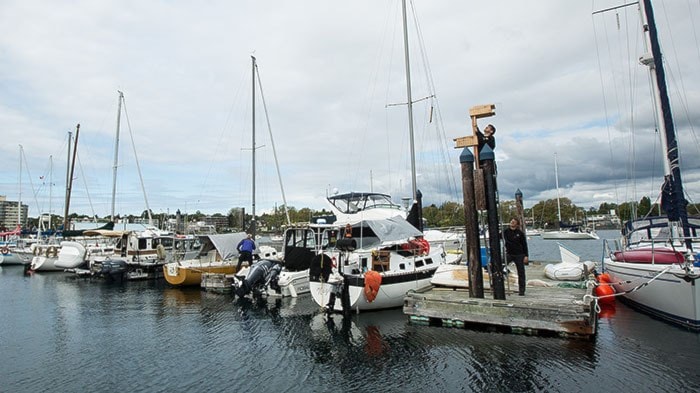Chris Sturrock balances precariously on a ladder.
With outstretched arms, he jimmies a home-made wooden box, partially wrapped in wire mesh, onto a wooden piling at the Oak Bay Marina. Finished, Sturrock slowly makes his way down the ladder onto the dock and looks over the new home, for what Sturrock says, is a very special bird.
“They are not your typical bird. … (Purple Martins) are entertaining, very cheeky and very acrobatic. They are really beautiful to watch, the movement and their song it is really neat,” he says. “They have certainly enriched my life and I think a lot of people are not aware that these birds are struggling to survive because of habitat destruction and loss of good nesting sites.”
The longtime sailor is doing something about it, working with the B.C. Purple Martin Recovery Program, building nesting boxes at a workshop underneath his Saanich home and installing them onto pilings at local docks where Purple Martins now make their homes. He has built nine such nesting boxes already, spread out over several sites including the Oak Bay Marina and Royal Victoria Yacht Club, both of which even agreed to fund the projects, More are planned for destinations as far as Sidney and North Saanich.
The conservation effort that started with a study in 1985 that found only five nesting pairs of Purple Martins remained in all of B.C., has grown into an initiative that has helped cultivate the population to more than 900 nesting pairs today.
“If volunteers had not started putting up nest boxes, there wouldn’t be Purple Martins in B.C. now,” said Georgia Basin Ecological Assessment and Restoration Society (GBEARS) coordinator Charlene Lee. “The old untreated pilings (former nesting sites for the birds) are all falling down and if people hadn’t noticed the birds were reducing in numbers, they wouldn’t be here.”
The Purple Martins, the largest in the swallow family in North America, are marked by their vibrant bluish-purple males, speckled greyish-brown breasted females and their unique and lively chirping song. The social birds were once commonly found in woodpecker cavities or rot pockets in Garry Oak Meadows, but were forced from their homes, to wooden dockside pilings when logging, snag removal and urban and rural development reduced the Garry Oak Meadows to the one per cent left today.
With the industrial pilings the birds moved to now rotting away and being replaced, Lee said the Purple Martins who make an annual 11,000 kilometre voyage from Vancouver Island to Brazil and back every winter, need the vigilance of volunteers more than ever. For his part, Sturrock continues to build and maintain the homes for the 65 active colonies living along the coastline from Sidney to Campbell River, awaiting their return from South America.
“I love birds, I love nature,” Sturrock said. “It is a great cause, and is one of those tangible feel good projects.”
For more information, to volunteer or to donate click here or here.
